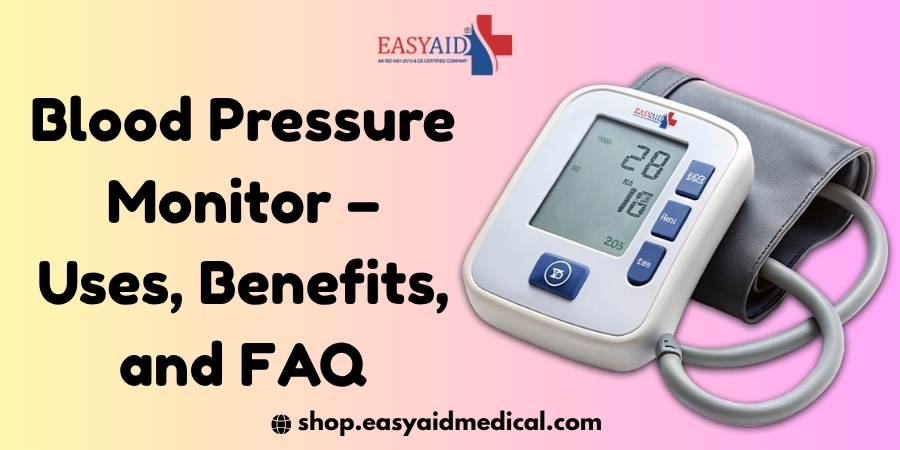A blood pressure monitor, also known as a BP machine, is an essential medical device used to measure blood pressure levels at home or in clinical settings.
With rising health awareness, many people now prefer to monitor their blood pressure regularly to manage hypertension, heart health, and overall wellness.
Modern digital BP monitors are compact, easy to use, and provide quick, accurate readings. This detailed FAQ answers the most common questions about using, maintaining, and choosing the right blood pressure monitor for your needs.
Also Read- Hot Water Rubber Bag – Uses, Benefits, and FAQ
Common FAQ About Blood Pressure Monitors
1. What is a blood pressure monitor?
A blood pressure monitor is a device that measures the force of blood pushing against the walls of your arteries.
It helps detect hypertension (high blood pressure) or hypotension (low blood pressure) early, allowing you to take preventive steps for heart health.
There are two main types:
- Manual (Aneroid) BP Monitor: Requires a stethoscope and hand inflation.
- Digital (Automatic) BP Monitor: Battery-operated, easy to use, and displays readings on an electronic screen.
2. How does a digital blood pressure monitor work?
A digital BP monitor uses an inflatable cuff that wraps around your upper arm or wrist.
When you press the start button, the cuff inflates and measures the changes in pressure caused by your heartbeat.
The device then shows two readings:
- Systolic Pressure (upper number) – pressure when the heart beats.
- Diastolic Pressure (lower number) – pressure when the heart rests between beats.
3. Why is monitoring blood pressure at home important?
Home monitoring helps you:
- Track your blood pressure trends over time
- Detect early signs of hypertension or heart problems
- Evaluate how well your medication or lifestyle changes are working
- Avoid “white coat hypertension” (when BP rises only in clinics due to anxiety)
- Share accurate readings with your doctor for better diagnosis
4. How do I choose the right blood pressure monitor?
When selecting a BP monitor, consider:
- Cuff Type: Upper arm cuffs are more accurate than wrist models.
- Size: Ensure the cuff fits your arm circumference properly.
- Features: Look for memory storage, average reading function, irregular heartbeat detection, and WHO indicator.
- Accuracy: Always choose a clinically validated model (approved by AAMI, ESH, or WHO standards).
- Ease of use: A large display and one-touch operation are ideal for home users.
5. How should I prepare before taking a reading?
To get accurate readings:
- Sit quietly for 5 minutes before measuring.
- Avoid coffee, smoking, or exercise 30 minutes before checking.
- Sit in a comfortable chair, feet flat on the floor, and back supported.
- Keep your arm at heart level and stay still during measurement.
- Take readings at the same time each day (morning or evening).
6. What is the correct way to use a blood pressure monitor?
Here’s how to use it step-by-step:
- Wrap the cuff snugly around your upper arm.
- Sit upright with your arm supported on a table.
- Press the Start button (for digital monitors).
- Wait as the cuff inflates and deflates automatically.
- Read the systolic and diastolic numbers displayed.
- Record your readings in a log or mobile app for tracking.
7. What do the blood pressure numbers mean?
According to WHO guidelines:
- Normal: Less than 120/80 mmHg
- Elevated: 120–129 / <80 mmHg
- High (Hypertension Stage 1): 130–139 / 80–89 mmHg
- High (Stage 2): 140+/90+ mmHg
- Hypertensive Crisis: Over 180/120 mmHg — seek medical help immediately.
8. How often should I check my blood pressure?
If you have normal BP, check it once every 1–2 weeks.
If you have hypertension, measure it daily or as advised by your doctor.
Always take 2–3 readings a few minutes apart and average them for accuracy.
9. Can I use a wrist BP monitor instead of an arm monitor?
Yes, wrist BP monitors are convenient and portable, but they tend to be less accurate than arm monitors because wrist arteries are narrower and closer to the skin.
Use them only if arm cuffs are uncomfortable or not suitable due to medical reasons.
10. What factors can affect blood pressure readings?
Several factors can cause inaccurate readings:
- Stress or anxiety
- Talking or moving during measurement
- Full bladder
- Incorrect cuff size or loose fitting
- Cuff placed over clothing
- Cold temperatures or improper posture
Always ensure a calm, consistent environment for accurate results.
11. Can blood pressure monitors detect irregular heartbeats?
Yes, many modern digital BP monitors have irregular heartbeat indicators that alert you if your heart rhythm seems abnormal.
However, this is only a screening tool — always confirm with an ECG or doctor’s evaluation.
12. How can I maintain and clean my blood pressure monitor?
Wipe the cuff and main unit with a soft, dry cloth after use.
- Avoid water, alcohol, or harsh cleaners.
- Store it in a cool, dry place, away from sunlight.
- Replace batteries promptly when the indicator shows low power.
- Calibrate your monitor once every 1–2 years for accuracy.
13. Are digital BP monitors accurate?
Yes — if you use a validated brand and follow the correct method.
Digital monitors are tested for clinical accuracy, but readings may slightly vary depending on the cuff size and posture.
For consistent results, compare your home readings with a clinic’s machine occasionally.
14. What is the lifespan of a blood pressure monitor?
With proper care, a good-quality BP monitor lasts 3–5 years.
Cuffs may need replacement sooner if they show signs of wear or loose fitting.
15. What are some popular blood pressure monitor brands in India?
Trusted and reliable brands include:
- Omron
- Dr. Morepen
- Beurer
- AccuSure
- EASYAID
- Rossmax
These brands offer both automatic and manual BP monitors with warranty and digital memory features.

